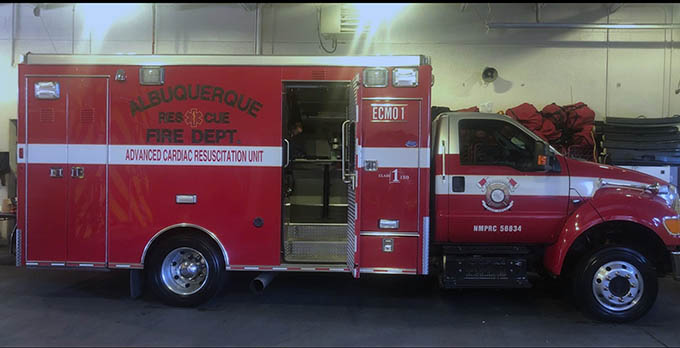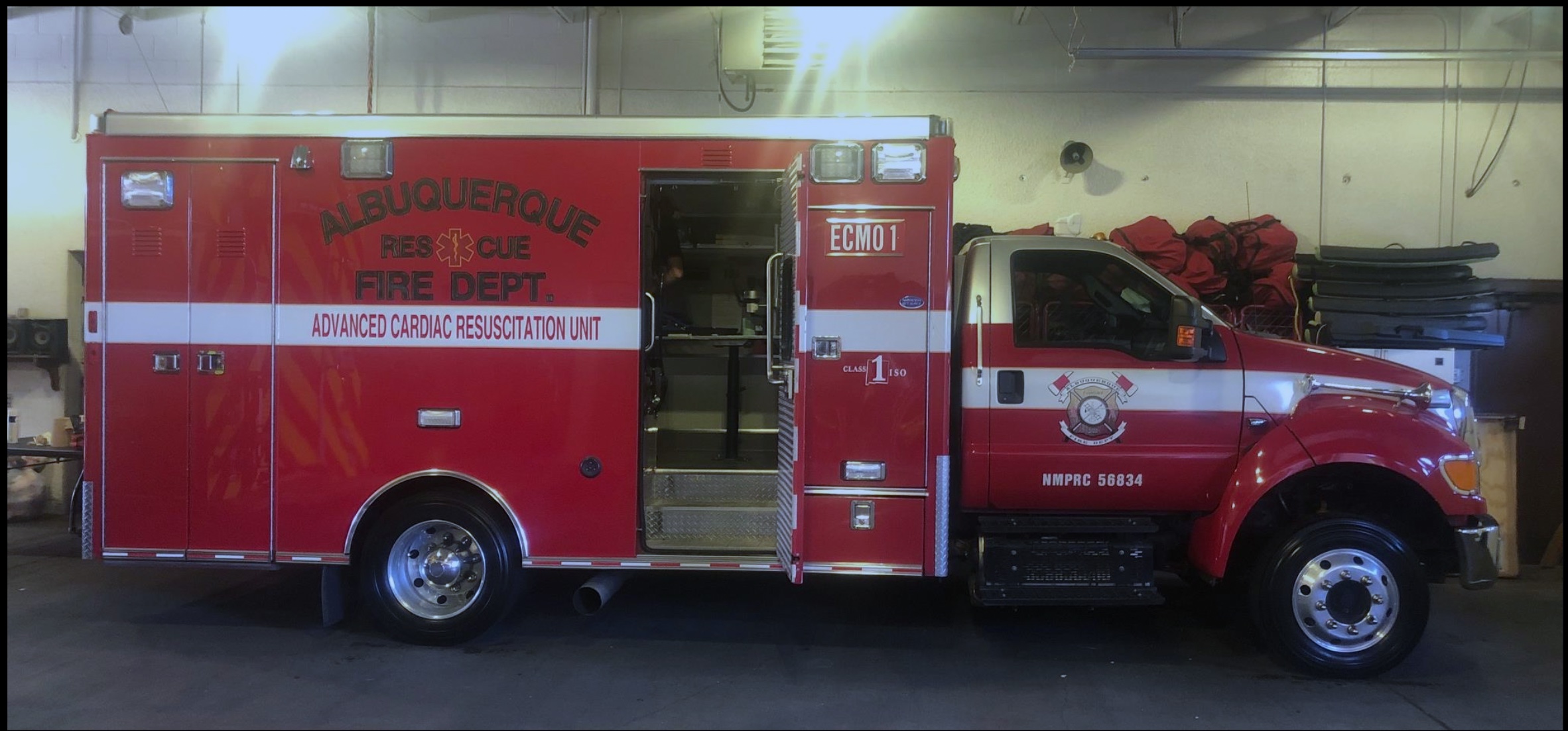When someone collapses in an out-of-hospital cardiac arrest – where the heart suddenly stops pumping blood – their best hope for survival is to receive prompt on-scene life support and then be sped to a hospital for further treatments.
But often, too much time elapses, and even if the patient’s heart is restarted, the brain has been irreversibly damaged from lack of oxygen.
Now, doctors at The University of New Mexico Hospital are partnering with Albuquerque Fire Rescue (AFR) to dispatch an ambulance-mounted heart-lung bypass machine to patients in the field, where it can be used to re-establish the flow of oxygen-rich blood to the brain much sooner.
The ECMO (Extra-Corporeal Membrane Oxygenation) machine takes over for the heart and lungs, giving doctors a chance to remove a clot or jump-start the heart with a defibrillator, says AFR medical director Kimberly Pruett, MD, an assistant professor in the UNM Department of Emergency Medicine.
“If we can get those people with that problem onto ECMO in time, it can buy time to fix the problem, whether it’s a heart attack or a blood clot,” she says.
Pruett and Jonathan Marinaro, MD, professor of Emergency Medicine and co-chief of the UNM Center for Adult Critical Care, were among the authors of a paper published in the journal Prehospital Emergency Care outlining the advantages of bringing ECMO to the patient, rather than providing life support onsite before taking them to the hospital for ECMO.
The research cited in the paper was based on pilot testing with AFR’s ECMO-1 ambulance unit conducted just before the COVID-19 pandemic arrived in 2020.

It’s in the patient’s best interest in terms of time to get them on the pump, to start ECMO and basically bring the hospital to them.
“Minutes matter,” Pruett says. “The question that drove this paper was what is better for the patient. The paper proved that it’s in the patient’s best interest in terms of time to get them on the pump, to start ECMO and basically bring the hospital to them. And it proves the concept that this mobile ECMO idea is the right direction to keep pursuing.”
A key consideration was that chest compressions from CPR alone don’t send enough oxygenated blood to the brain, Marinaro says. ECMO provides three or four times as much blood flow to the brain – enough to keep neural tissue alive until the heart can be restarted.
“The thing I like to impress on people is that 85 percent if people who die of cardiac arrest die for neurologic reasons,” Marinaro says. “CPR provides a fifth of normal cardiac output at best, so all Kim and I have to do is beat 20 percent of normal cardiac output and we’re going be saving lives at a greater percentage.”
The specially outfitted ECMO-1 ambulance is based at Fire Station 3 on Girard Boulevard, a short drive from UNM Hospital. When it is dispatched, it will swing by the hospital to pick up an on-call physician and then race to the patient, where other first responders will have already started CPR and other measures.

With the help of paramedics, the physician inserts a finger-thick tube called a cannula into a vein in one leg and an artery in the other, then switches on the ECMO machine, which can continue running as the ambulance heads to the hospital.
Pruett says the pilot project was put on hold in 2020 due to the pandemic, which saw the frequent use of ECMO equipment for seriously ill COVID patients. She expects AFR will soon restart technical training for the paramedics who ride in ECMO-1, while paramedics and emergency medical technicians throughout the department will need to be updated regarding the new protocol for cardiac arrest cases.
“Right now, we just work cardiac arrests on scene,” she says. “It’s a change in procedure to think about moving a patient who’s in cardiac arrest.”
Dispatchers will only call out the ECMO team in cases where a cardiac arrest has been witnessed, CPR is underway and the patient is under 65. “As long as the dispatcher can confirm those three things then they’ll go ahead and dispatch the ECMO unit to the scene,” Pruett says.
She expects the program to be fully operational by January 2023.

